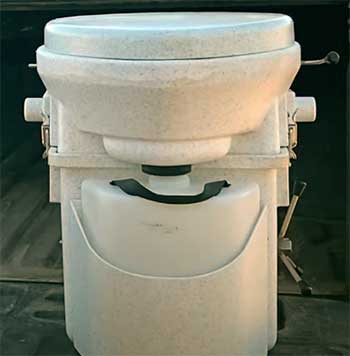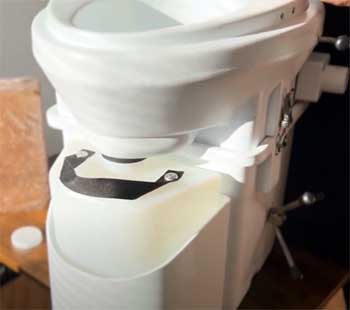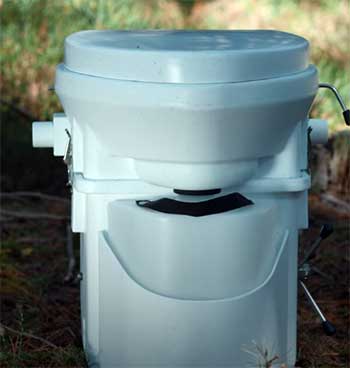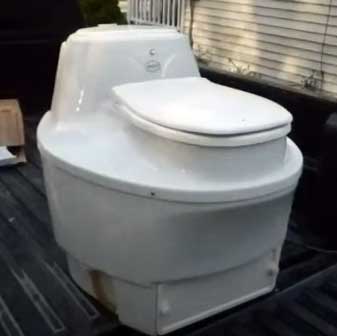If you’re chasing freedom in a tiny home, RV, or boat, the Nature’s Head Composting Toilet is your ticket to off-grid bliss. I’ve lived with this game-changer for years, and trust me, it’s not just a toilet—it’s a lifestyle upgrade.
No black tanks, no sewage stench, just eco-friendly simplicity that works. Whether you’re boondocking in Montana or sailing coastal Maine, this toilet delivers comfort and convenience without the hassle.
Ready to ditch traditional plumbing? Let’s explore why this is the smartest investment you’ll make for your nomadic adventures.
My Journey With The Nature’s Head Composting Toilet

Picture this: I’m parked in the middle of nowhere, surrounded by Montana’s rolling hills, living in my vintage Airstream.
No hookups, no dump stations for miles, and yet, I’m as comfortable as ever, thanks to my Nature’s Head Composting Toilet.
I bought this gem in 2021, and it’s been my trusty companion for six months of travel each year.
From the moment I installed it, I knew I’d made the right call.
The setup was a breeze. I’m no handyman, but with a few basic tools, I had it bolted down in under an hour. I adapted the vent hose to my Airstream’s existing exhaust, trimmed it to fit, and voilà—no complicated plumbing required.
The toilet’s design is intuitive, separating liquids from solids to prevent that dreaded sewage smell. I use coconut coir as the composting medium, which I store in a covered bin outside.
Prepping it is simple: soak the brick, break it apart, and scoop it into the solids bin. It’s clean, earthy, and surprisingly satisfying to set up.
Daily use is just as straightforward. I empty the urine container every couple of days—easy enough, just unscrew the cap and pour it into a pit toilet or, if I’m boondocking, responsibly onto non-edible plants.
After each use, I spritz the bowl with a vinegar-water mix to keep things fresh. The solids bin? I only deal with that every four weeks or so. It’s not glamorous, but it’s manageable.
I stretch a compostable bag over the bin, invert it, and transfer the contents for further composting. No foul odors, no mess—just a musty, soil-like material that’s shockingly inoffensive.
What I love most is the freedom. I can camp wherever my heart desires without worrying about black tanks or dump stations. On my sailboat, it’s been a game-changer too. No more sloshing holding tanks or calcium-crusted hoses.
It’s just me, the open water, and a toilet that doesn’t complain. Sure, it’s a bit tall for shorter folks, and I had to add a platform on my boat, but these are small trade-offs for the peace of mind it brings.
The Pros of Owning A Nature’s Head Composting Toilet
- Water Conservation That Feels Good

Let’s talk about saving water—because who doesn’t want to feel like an eco-warrior?
The Nature’s Head is completely waterless, which means you’re not flushing gallons down the drain every time you go.
In a world where water scarcity is a growing concern, this feels like a small but mighty win.
I’ve camped in drought-prone areas, and knowing I’m not wasting a drop makes me proud.
Plus, it’s one less thing to worry about when you’re off-grid with limited freshwater tanks.
- Odor-Free Living
You’re probably thinking, “A toilet with no flush? That’s gotta stink.” Nope. The Nature’s Head’s ventilation system is a marvel. A small 12-volt fan runs constantly, pulling air through the solids bin and out the vent hose.
I’ve had guests use it, and not once has anyone complained about a smell. Even when I empty the urine container, it’s only a brief whiff—nothing like the sewage stench of traditional RV toilets.
Spray a little vinegar-water mix after each use, and your bathroom stays fresh as a daisy.
- Hassle-Free Installation
I’m not exaggerating when I say installation is a snap. If you can wield a screwdriver, you can set this up. The toilet comes pre-assembled, so all you do is bolt it to the floor and connect the vent hose.
On my Airstream, I repurposed the existing vent, and on my sailboat, I routed it through a small hole. No plumber needed, no complicated wiring. The fan plugs into a 12-volt system, or you can opt for a solar vent if you’re fully off-grid. It’s designed for real people, not just DIY pros.
- Massive Capacity for Full-Time Use
For a compact toilet, the Nature’s Head holds an impressive amount. The solids bin can handle 60-80 uses, which translates to about 4-6 weeks for two people living full-time.
I empty mine every four weeks as a single user, and it’s never felt like a chore. The urine container needs more frequent attention—every 2-3 days for me—but it’s a quick task that takes less than five minutes.
This capacity means you can stay off-grid longer without worrying about waste management.
- Eco-Friendly Waste Management
This toilet doesn’t just save water; it transforms waste into something manageable. The solids, mixed with coconut coir or peat moss, start composting in the bin, turning into a dry, soil-like material.
I dispose of mine in compostable bags for further composting, but even if you toss it in a dumpster, it’s not toxic sewage. Urine, when diluted, can fertilize non-edible plants safely. It’s a closed-loop system that feels good for the planet and keeps your conscience clean.
The Cons of The Nature’s Head Composting Toilet
- Upfront Cost Can Sting

Let’s be real: the Nature’s Head isn’t cheap. At around $1,000, it’s a significant investment.
When I first bought it, I hesitated, wondering if I could get by with a cheaper portable toilet.
But after years of use, I can say it’s worth every penny for the convenience and durability.
Still, if you’re on a tight budget, the price tag might make you wince.
You’ll also need to factor in occasional costs for coconut coir or peat moss, though a bale costs just $5-$10 and lasts months.
- Space and Height Challenges
This toilet is compact but not tiny. It’s taller than most marine or RV toilets, which can be awkward in small spaces. On my sailboat, I had to build a 3-inch platform to make it comfortable for shorter crew members, and I wish I’d gone for 6 inches.
You also need enough clearance to tilt the lid and remove the solids bin, so measure your space carefully. In my Airstream’s narrow bathroom, I placed it on a rubber mat instead of bolting it down, which works but requires careful maneuvering when emptying.
- Urine Container Requires Frequent Emptying
The urine container is a blessing and a curse. It’s easy to empty—just unscrew the cap and pour—but you’ll be doing it often. For one person, I empty it every 2-3 days; for two, it might be daily. If you’re not diligent, overflow into the solids bin can cause odors and mess up the composting process. I learned this the hard way early on.
Now, I empty it proactively and rinse it with soapy water to keep things odor-free. It’s not a dealbreaker, but it’s a routine you can’t skip.
- Cleaning Isn’t Always a Breeze
While the Nature’s Head is low-maintenance compared to traditional toilets, cleaning isn’t effortless. The solids bin’s agitator doesn’t reach the corners, so damp compost can stick, requiring manual scraping.
I use biodegradable dish soap and water to clean it monthly, but it’s a hands-on job. The urine spout is also tricky to access, so I rely on my vinegar spray to keep it fresh. It’s not backbreaking, but if you hate cleaning, this might feel like a chore.
- Not Fully Composted Waste
Don’t expect garden-ready compost straight from the bin. The Nature’s Head starts the composting process, but the solids aren’t fully broken down when you empty them. I transfer mine to a dedicated compost system for two years before using it on non-edible plants.
If you’re hoping for instant fertilizer, you’ll be disappointed. Most users, including me, bag the solids in compostable bags and dispose of them responsibly, which is still better than dealing with raw sewage.
Maintenance Tips For Your Nature’s Head Composting Toilet
- Keep the Fan Running
The fan is your best friend. It runs on minimal power—think 12 volts—and keeps odors at bay by pulling air through the vent hose. I leave mine on 24/7, and it’s never let me down.
If you’re in a cold climate, check the fan occasionally, as one user I know had theirs fail in harsh winters. A solar vent is a great option if you’re fully off-grid. Whatever you do, don’t skip the fan—it’s the secret to a smell-free bathroom.
- Master the Vinegar Spray
After every use, especially for liquids, give the bowl a quick spritz with a water-vinegar mix. I keep a small spray bottle next to the toilet with a 1:1 ratio of water and white vinegar.
It cleans the urine passages, prevents buildup, and keeps odors in check. If solids stick to the bowl, a couple of sprays and a wipe with a biodegradable cloth do the trick. This habit takes 10 seconds and makes a world of difference.
- Prep Your Composting Medium Right
Whether you use coconut coir or peat moss, getting the moisture level right is key. I soak my coir brick in water for 30 minutes, then break it apart with my hands until it’s damp but not soggy.
Too wet, and you’ll get mold; too dry, and it won’t compost effectively. Store extra medium in a sealed bin outside to keep it fresh. Only add medium at the start—piling more in later can clog the bin and reduce capacity.
- Empty the Urine Container Proactively
Don’t wait for the urine container to hit full capacity. I empty mine every 2-3 days, even if it’s not full, to avoid spills or overflow. Rinse it with a splash of dish soap and water after each empty, and use disinfectant wipes around the connection point to prevent odor buildup.
If you’re boondocking, pour urine into a pit toilet or dilute it for non-edible plants. This routine keeps the system running smoothly.
- Clean the Solids Bin Monthly
Every four weeks, I deep-clean the solids bin. Remove the toilet from its base, dump the contents into a compostable bag, and scrub the bin with biodegradable dish soap and water. Avoid bleach or ammonia—it kills the good bacteria.
Let it air dry completely before adding fresh coir. If you notice damp compost sticking in the corners, clean more frequently to prevent buildup. This takes about 20 minutes but keeps the toilet in top shape.
Comparison With Other Composting Toilet Brands
Choosing the Nature’s Head Composting Toilet wasn’t a snap decision—I spent weeks weighing it against other brands to find the perfect fit for my off-grid life in my Airstream and sailboat.
To help you decide, I’ll pit the Nature’s Head head-to-head against three competitors: the Sun-Mar Excel, BioLet Composting Toilet, and OGO Composting Toilet. Each comparison dives into the factors that matter most, from design to cost, so you can see why I’m sold on my Nature’s Head.
Nature’s Head Vs. Sun-Mar Excel
- Design and Portability: The Nature’s Head is a lean, mean 28-pound machine built for mobility. I had it bolted into my Airstream in under an hour, and its rugged plastic body handles the bumps of travel like a champ. The Sun-Mar Excel, at 60 pounds, is a stationary giant better suited for cabins. Its bulky frame and need for a 110-volt outlet (or a costly 12-volt adapter) make it a no-go for my nomadic setup. If you’re living on the move like me, the Nature’s Head’s lightweight, portable design wins hands-down.
- Maintenance and Odor Control: With the Nature’s Head, maintenance is simple: empty the urine container every 2-3 days, spritz with vinegar, and dump the solids bin every 4-6 weeks. The 12-volt fan keeps odors nonexistent—I’ve had guests use it without a whiff of complaint. The Sun-Mar Excel automates composting with a heater and fan, but this adds complexity. You don’t separate liquids and solids, which simplifies use but can lead to smells if the drum overfills. For reliable, low-tech odor control, I stick with the Nature’s Head.
- Cost and Value: The Nature’s Head’s $1,000 price tag stung, but its 5-year warranty and low maintenance costs make it a solid investment. The Sun-Mar Excel is pricier, often $1,200-$1,500, due to its electric components and larger capacity. While it’s great for stationary homes with multiple users, its power demands and bulk don’t suit my off-grid life. The Nature’s Head’s durability and simplicity offer better value for my mobile adventures.
Nature’s Head Vs. BioLet Composting Toilet

- Installation and Setup: Installing the Nature’s Head was a DIY dream. I connected the vent hose to my Airstream’s exhaust and plugged the 12-volt fan in—no fuss, no plumber. The BioLet Composting Toilet (like the BioLet 65) is more demanding, requiring a 110-volt outlet and a dedicated vent system. Its 70-pound frame needs leveling and securing, which feels like overkill for my boat or RV. For quick, user-friendly setup, the Nature’s Head is my pick.
- Waste Management: The Nature’s Head’s liquid-solid separation is straightforward: I use coconut coir, empty urine every 2-3 days, and bag solids monthly for composting. The waste isn’t fully composted, but it’s odor-free and easy to handle. The BioLet aims for more complete composting with a heated chamber and auto-mixing, reducing manual work. However, its waste tray is harder to empty in tight spaces, and its 320-watt power draw is a dealbreaker off-grid. I prefer the Nature’s Head’s low-power, hands-on system.
- Cost and Value: At $1,000, the Nature’s Head isn’t cheap, but its simplicity and 5-year warranty justify the cost. The BioLet is pricier, often $1,300-$1,600, due to its automated features. While these sound nice, the higher price and power needs don’t align with my minimalist setup. The Nature’s Head’s lower operating costs and durability make it the better long-term investment for me.
Nature’s Head Vs. OGO Composting Toilet
- Size and Features: The Nature’s Head is compact but sturdy, fitting my Airstream and sailboat with room to spare. Its manual crank and 60-80-use solids bin suit my needs, backed by a 5-year warranty. The OGO Composting Toilet is slightly smaller and lighter at 25 pounds, with an electric agitator and a liquid level indicator—techy perks I admit I’m jealous of. But its 50-60-use solids capacity and 2-year warranty fall short. For reliability and capacity, I chose the Nature’s Head.
- Maintenance and Odor Control: The Nature’s Head’s 12-volt fan and vinegar spritz keep my bathroom odor-free, with urine emptied every 2-3 days and solids monthly. The OGO’s fan is equally effective, and its electric agitator skips the manual cranking, which is nice. Both are waterless and low-maintenance, but the OGO’s smaller solids bin means more frequent emptying. I value the Nature’s Head’s larger capacity for longer off-grid stretches.
- Cost and Value: The OGO, at around $900, undercuts the Nature’s Head’s $1,000 price, and its modern features feel like a steal. But the Nature’s Head’s larger solids bin and longer warranty save money over time, especially for full-time use. The OGO’s smaller capacity means buying more composting medium, which adds up. For my lifestyle, the Nature’s Head’s proven track record and cost-effectiveness make it the smarter buy.
Frequently Asked Questions (FAQ)
Yes, you can put toilet paper in the Nature’s Head, but it’s best to use biodegradable or RV-specific brands that break down faster. I toss mine in the solids bin, and it composts along with the waste, though it stays visible longer than solids. If you prefer, you can dispose of toilet paper in a separate trash bin to reduce bulk in the solids compartment. Avoid non-biodegradable items like wipes or tampons—they won’t decompose and can clog the system.
Composting toilets like the Nature’s Head have a few quirks. The upfront cost—around $1,000—can be steep, and you’ll need to buy composting medium periodically. They require regular maintenance, like emptying the urine container every few days and cleaning the solids bin monthly. Space can be an issue; the toilet’s height and clearance needs don’t suit every setup. The waste isn’t fully composted when emptied, so you’ll need a plan for disposal. Lastly, there’s a slight adjustment period to get used to the system, especially for guests.
It depends on usage. For one person, I empty the urine container every 2-3 days and the solids bin every 4 weeks. For two people full-time, expect to empty the urine container daily and the solids bin every 3-4 weeks. The solids bin holds 60-80 uses, so occasional use (like weekends) can stretch it to 2 months or more. Emptying the urine container takes 5 minutes; the solids bin takes about 20 minutes with cleaning.
Yes, but it’s minimal. The Nature’s Head uses a 12-volt fan to control odors and aid composting, drawing very little power—perfect for RVs or boats with solar setups. You can also get a solar vent option for fully off-grid use. I’ve never noticed a significant drain on my battery, and the fan runs 24/7. If you skip the fan, you risk odors, so it’s not optional in my book.
Conclusion: Your Off-Grid Dream Awaits
The Nature’s Head Composting Toilet isn’t just a purchase—it’s a commitment to freedom and sustainability.
After years of use, I can’t imagine going back to traditional toilets. It’s reliable, odor-free, and lets me live anywhere without worrying about plumbing or dump stations.
From Montana’s wilds to Maine’s coast, it’s been my partner in adventure. If you’re ready to embrace off-grid living with confidence, grab a Nature’s Head. You won’t regret it.
